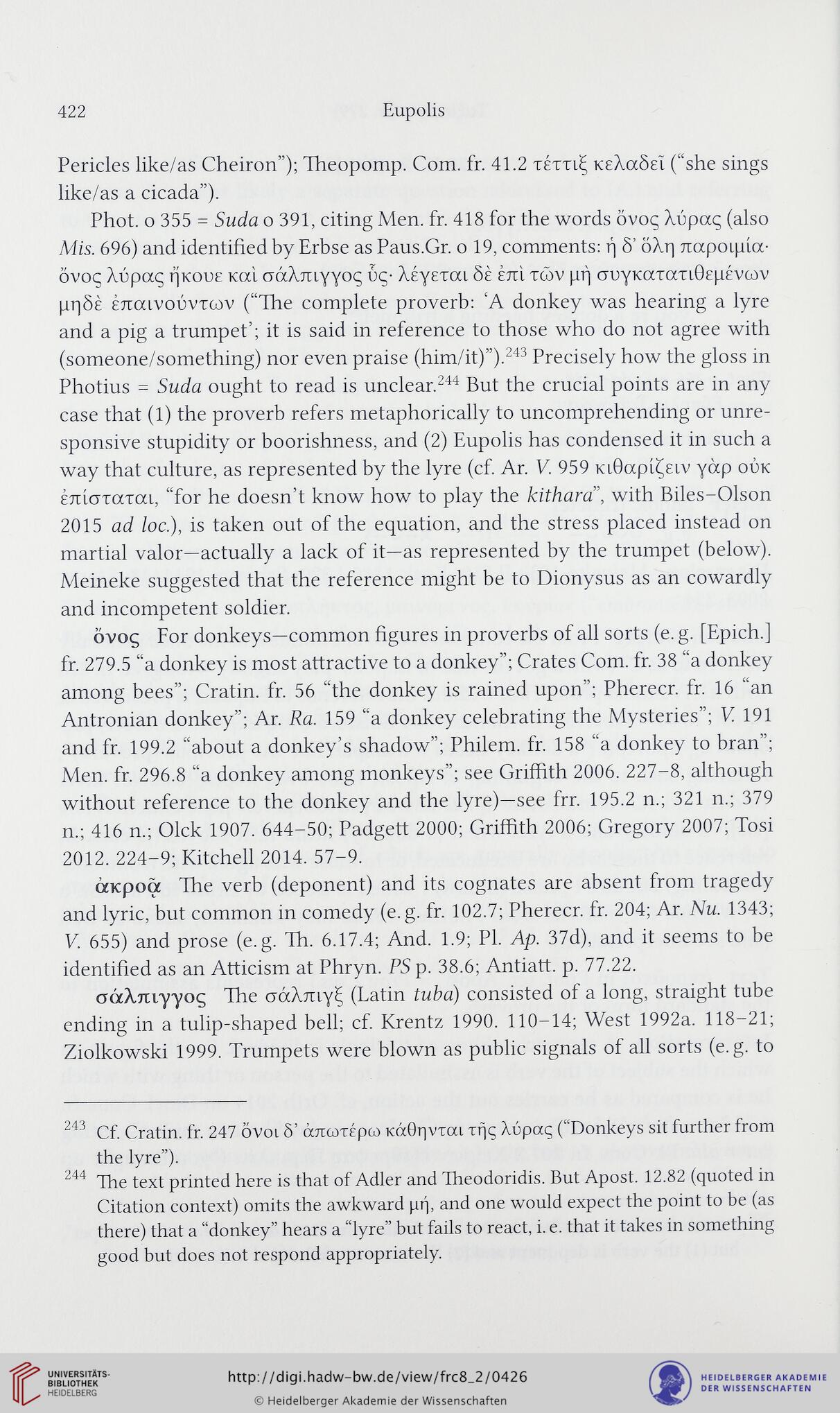422
Eupolis
Pericles like/as Cheiron”); Theopomp. Com. fr. 41.2 τέττιξ κελαδεΐ (“she sings
like/as a cicada”).
Phot, o 355 = Suda o 391, citing Men. fr. 418 for the words όνος λύρας (also
Mis. 696) and identified by Erbse as Paus.Gr. o 19, comments: ή δ’ όλη παροιμία-
όνος λύρας ήκουε καί σάλπιγγος ΰς· λέγεται δε επί των μή συγκατατιθεμένων
μηδέ έπαινούντων (“The complete proverb: ‘A donkey was hearing a lyre
and a pig a trumpet’; it is said in reference to those who do not agree with
(someone/something) nor even praise (him/it)”).243 Precisely how the gloss in
Photius = Suda ought to read is unclear.244 But the crucial points are in any
case that (1) the proverb refers metaphorically to uncomprehending or unre-
sponsive stupidity or boorishness, and (2) Eupolis has condensed it in such a
way that culture, as represented by the lyre (cf. Ar. V. 959 κιθαρίζειν γάρ ούκ
έπίσταται, “for he doesn’t know how to play the kithara”, with Biles-Olson
2015 ad loc.), is taken out of the equation, and the stress placed instead on
martial valor—actually a lack of it—as represented by the trumpet (below).
Meineke suggested that the reference might be to Dionysus as an cowardly
and incompetent soldier.
όνος For donkeys—common figures in proverbs of all sorts (e. g. [Epich.J
fr. 279.5 “a donkey is most attractive to a donkey”; Crates Com. fr. 38 “a donkey
among bees”; Cratin. fr. 56 “the donkey is rained upon”; Pherecr. fr. 16 “an
Antronian donkey”; Ar. Ra. 159 “a donkey celebrating the Mysteries”; V. 191
and fr. 199.2 “about a donkey’s shadow”; Philem. fr. 158 “a donkey to bran”;
Men. fr. 296.8 “a donkey among monkeys”; see Griffith 2006. 227-8, although
without reference to the donkey and the lyre)—see frr. 195.2 n.; 321 n.; 379
n.; 416 n.; Olck 1907. 644-50; Padgett 2000; Griffith 2006; Gregory 2007; Tosi
2012. 224-9; Kitchell 2014. 57-9.
άκροά The verb (deponent) and its cognates are absent from tragedy
and lyric, but common in comedy (e. g. fr. 102.7; Pherecr. fr. 204; Ar. Nu. 1343;
V 655) and prose (e.g. Th. 6.17.4; And. 1.9; Pl. Ap. 37d), and it seems to be
identified as an Atticism at Phryn. PS p. 38.6; Antiatt. p. 77.22.
σάλπιγγος The σάλπιγξ (Latin tuba) consisted of a long, straight tube
ending in a tulip-shaped bell; cf. Krentz 1990. 110-14; West 1992a. 118-21;
Ziolkowski 1999. Trumpets were blown as public signals of all sorts (e.g. to
243 Cf. Cratin. fr. 247 όνοι δ’ άπωτέρω κάθηνται τής λύρας (“Donkeys sit further from
the lyre”).
244 The text printed here is that of Adler and Theodoridis. But Apost. 12.82 (quoted in
Citation context) omits the awkward μή, and one would expect the point to be (as
there) that a “donkey” hears a “lyre” but fails to react, i. e. that it takes in something
good but does not respond appropriately.
Eupolis
Pericles like/as Cheiron”); Theopomp. Com. fr. 41.2 τέττιξ κελαδεΐ (“she sings
like/as a cicada”).
Phot, o 355 = Suda o 391, citing Men. fr. 418 for the words όνος λύρας (also
Mis. 696) and identified by Erbse as Paus.Gr. o 19, comments: ή δ’ όλη παροιμία-
όνος λύρας ήκουε καί σάλπιγγος ΰς· λέγεται δε επί των μή συγκατατιθεμένων
μηδέ έπαινούντων (“The complete proverb: ‘A donkey was hearing a lyre
and a pig a trumpet’; it is said in reference to those who do not agree with
(someone/something) nor even praise (him/it)”).243 Precisely how the gloss in
Photius = Suda ought to read is unclear.244 But the crucial points are in any
case that (1) the proverb refers metaphorically to uncomprehending or unre-
sponsive stupidity or boorishness, and (2) Eupolis has condensed it in such a
way that culture, as represented by the lyre (cf. Ar. V. 959 κιθαρίζειν γάρ ούκ
έπίσταται, “for he doesn’t know how to play the kithara”, with Biles-Olson
2015 ad loc.), is taken out of the equation, and the stress placed instead on
martial valor—actually a lack of it—as represented by the trumpet (below).
Meineke suggested that the reference might be to Dionysus as an cowardly
and incompetent soldier.
όνος For donkeys—common figures in proverbs of all sorts (e. g. [Epich.J
fr. 279.5 “a donkey is most attractive to a donkey”; Crates Com. fr. 38 “a donkey
among bees”; Cratin. fr. 56 “the donkey is rained upon”; Pherecr. fr. 16 “an
Antronian donkey”; Ar. Ra. 159 “a donkey celebrating the Mysteries”; V. 191
and fr. 199.2 “about a donkey’s shadow”; Philem. fr. 158 “a donkey to bran”;
Men. fr. 296.8 “a donkey among monkeys”; see Griffith 2006. 227-8, although
without reference to the donkey and the lyre)—see frr. 195.2 n.; 321 n.; 379
n.; 416 n.; Olck 1907. 644-50; Padgett 2000; Griffith 2006; Gregory 2007; Tosi
2012. 224-9; Kitchell 2014. 57-9.
άκροά The verb (deponent) and its cognates are absent from tragedy
and lyric, but common in comedy (e. g. fr. 102.7; Pherecr. fr. 204; Ar. Nu. 1343;
V 655) and prose (e.g. Th. 6.17.4; And. 1.9; Pl. Ap. 37d), and it seems to be
identified as an Atticism at Phryn. PS p. 38.6; Antiatt. p. 77.22.
σάλπιγγος The σάλπιγξ (Latin tuba) consisted of a long, straight tube
ending in a tulip-shaped bell; cf. Krentz 1990. 110-14; West 1992a. 118-21;
Ziolkowski 1999. Trumpets were blown as public signals of all sorts (e.g. to
243 Cf. Cratin. fr. 247 όνοι δ’ άπωτέρω κάθηνται τής λύρας (“Donkeys sit further from
the lyre”).
244 The text printed here is that of Adler and Theodoridis. But Apost. 12.82 (quoted in
Citation context) omits the awkward μή, and one would expect the point to be (as
there) that a “donkey” hears a “lyre” but fails to react, i. e. that it takes in something
good but does not respond appropriately.




